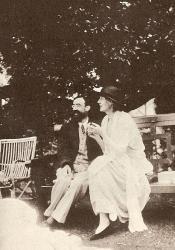(1925) "Mrs. Dalloway" by Virginia Woolf
Published in 1925, Mrs. Dalloway is a novel written by English author Virginia Woolf in a style is now referred to as "stream-of-consciousness". Like an epistolary novel, the narrative voice remains in the first-person and in the mind of the character. While both styles are told through the thoughts f character's, Woolf's style allows for a more surreal atmoshphere and loosely connected thoughts that lead to others, lead off on tangents, or sometimes feel incoherent, "Her method is poetic and the action of her fiction occurs essentially within the human consciousness." (McNichol) Unlike the epistolary novel, such as Barford Abbey (1768) written by Susannah Gunning, the narrative voice can serve as a way to recount the plot but in Mrs. Dalloway it is often free from that obligation. The novel recounts the life in a day of ordinary people in London several years after the end of the First World War. The central character Mrs. Dalloway is hosting a party in the evening and the narrative voice slips from her mind to those around her, connecting the lives and actions of strangers through sometimes only second-long interactions. This makes the conveyence of the plot difficult, but as Stella McNichol describes in her essay on Woolf, "This is because [Mrs. Dalloway] concerns itself with mental processes and with charting and fluctuations of the emotional response to existence" (McNichol).
McNichol, Stella. "Virginia Woolf: Overview." Reference Guide to English Literature, edited by D. L. Kirkpatrick, 2nd ed., St. James Press, 1991. Gale Literature Resource Center, link.gale.com/apps/doc/H1420008789/LitRC?u=sand82993&sid=bookmark-LitRC&xid=fe73faa8. Accessed 1 June 2021.
Woolf, Virginia. Mrs. Dalloway. Harcourt, 2002.

